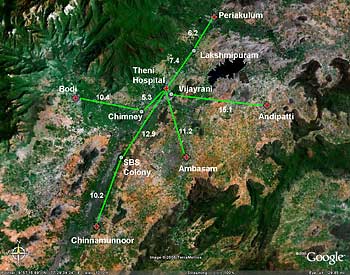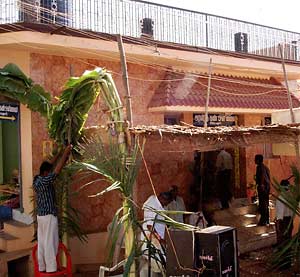UC Berkeley Press Release
 |
On opening day of the Periakulum rural vision center, a nurse and a doctor from Aravind Eye Hospital examine a patient. Normally, the center is staffed by a single nurse who uses a computer network designed by researchers at UC Berkeley to teleconference with an eye specialist at a hospital 10 miles away. (Sonesh Surana photos) |
New wireless networking system brings eye care to thousands in India
BERKELEY – Thousands of residents of rural villages in India are receiving quality eye care thanks to a collaborative effort between an Indian hospital network and the researchers at the University of California, Berkeley, and at Intel Corporation who have developed a new technology for low-cost rural connectivity.
 This web video clip shows an eye clinic patient being interviewed via wireless teleconference. |
This new technology, based on "Wi-Fi" wireless networks, allows eye specialists at Aravind Eye Hospital at Theni in the southern India state of Tamil Nadu to interview and examine patients in five remote clinics via a high-quality video conference.
Just 17 months old, the pilot project has proved so successful that the partners are announcing this week that it will be expanded in the state to include five hospitals that will be linked to 50 clinics that are expected to serve half a million patients each year.
"The information technology revolution holds tremendous potential for addressing problems in developing countries," said Eric Brewer, a UC Berkeley professor of computer science and director of the Intel Research Berkeley lab who initiated efforts to develop the technology. "Historically, though, most projects have been either too expensive or too technologically complex to be used in poor, rural areas. What we've done here is develop a simple, inexpensive software and hardware system that can provide villages with a high-bandwidth connection to computer networks in cities as far as 50 miles away."
 In this satellite map graphic of the Aravind network, green lines indicate links from the central hospital to rural vision centers in five rural towns. All distances are in kilometers. (Graphic by Sonesh Surana) |
With high-speed links to the hospital, three of the clinics, also known as vision centers, screen about 1,500 patients each month. (Numbers are not yet available for the two other centers, which came online in May 2006.) Centers are run by a nurse trained in eye care. Patients first see the nurse, then spend about five minutes on a web camera consulting with an Aravind doctor. If the doctor determines that a closer examination or an operation is necessary, the patient is given a hospital appointment.
Typically patients receive glasses, medicine or remote diagnoses for more serious problems that often require a hospital appointment or surgery. About 5-10 percent of patients - already about 100 people a month - experience significant vision improvement as a result of treatment, usually by cataract surgery. A recent study conducted by the hospital showed that following treatment, 85 percent of the men and 58 percent of the women who had lost their jobs due to sight impairment were reintegrated into the workforce.
"We're addressing a shortage of doctors by allowing patients to go to a local center first. Once diagnosed locally, if they need to go to the hospital, they will actually go, because they know that they need to, that they'll get treatment, and that often it's free," Brewer said. "The bottom line is that they wouldn't otherwise go to the hospital, due to the long distance, the need to take someone with them, and the corresponding loss of income."
Brewer's work with Aravind Eye Hospitals is one of several projects he and a group of UC Berkeley computer science students and postdoctoral researchers have initiated through their Technology and Infrastructure for Emerging Regions (TIER) project. The TIER research team works with the Intel Research Berkeley lab team on the Aravind Eye Hospitals research project and on other activities through an open collaborative research agreement between Intel and UC Berkeley.
TIER is sponsored by UC Berkeley's Center for Information Technology Research in the Interest of Society (CITRIS.)
With the goal of designing hardware and software infrastructures for the demanding conditions of developing regions, one of the group's first priorities was to develop inexpensive and robust wireless networking technology.
The 802.11 networking standard, more commonly known as "Wi-Fi", is defined by a set of international standards that limit its range to about 200 feet. (This is why computer-toting travelers cluster in groups at Wi-Fi "hotspots" at airports and cafes, and why a laptop user on the street can horn in on Wi-Fi from a nearby house.)
 The rural vision center in Chinnamunoor in the state of Tamil Nadu, India. |
Brewer and his group first pinpointed the factors that make these standards ill-suited for long distance networking, then developed software to overcome the limitations. Combining their software with directional antennas and routers to send, receive and relay signals, the team has so far been able to obtain network speeds of up to six Mb/s at distances up to 40 miles.
These speeds are about 100 times faster than dial-up speeds and carry 100 times as far as regular Wi-Fi. The technology allows anyone with about $800 for a pair of small computers with directional antennas to network with another location within 50 miles and in line of sight. If there happens to be a hill in the way, no problem: A couple more antennas at the high spot can relay the signal between stations.
"If they can find a partner with high-speed networking within 50 miles, this is a great solution for communities around the world to get connected," Brewer said. "Once they've installed the initial system, there's very little ongoing cost for operation, in part because each end requires very little power and can even run off of solar."
With their new system in hand, the TIER group looked around for a suitable place to put it to work and found the Aravind Eye Hospitals.
The original Aravind Eye Hospital was established in 1976 with the mission of eradicating needless blindness in Tamil Nadu. Relying on its financially sustainable model of high volume and low cost, the organization has grown in the state into a network of five eye hospitals that provide care for anyone with eye problems.
In an effort to reach the 70 percent of its target population that lives in rural areas, hospital administrators came up with the concept of establishing village vision centers where patients could receive basic eye care backed up by online videoconferencing with doctors at the hospitals.
But here they ran into a roadblock: In some areas, there were no Internet service providers whatsoever, and in areas where there were providers, service was not only very expensive, but it was too slow for effective videoconferencing, with typical dial-up speeds of 33 to 35 kbps.
In August 2004, Sonesh Surana, one of Brewer's Ph.D. students in computer science, made a one-day trip to Aravind.
"I did an initial survey and realized that the telemedicine project that they wanted to do was a really good fit. They had this need, and we had a solution," Surana said.
Surana returned to Aravind with other TIER members four months later to work with Aravind staff and local vendors. They installed the long-distance Wi-Fi system in a vision center in the village of Ambasamudram, about seven miles from the Aravind hospital in Theni.
 This patient at a rural vision center in the town of Periakulum is teleconferencing with an eye specialist at a hospital 10 miles away. |
"It took about a year," Surana said, "but by the beginning of 2006, the new system was up and running reliably, and they were using it for everything."
In January and March 2006, the TIER team again worked with Aravind and local vendors to install systems in two more vision centers. And a week ago, at the end of May, Aravind staff and vendors trained by Surana and others installed another two systems, this time with no help from TIER.
"So many times people have come into an area to do a project and then, when they leave, everything falls apart," Surana said. "It's been a very important part of our work to make this a project that people can build and manage all on their own."
Other TIER members participating in the project are computer science graduate students Rabin Patra and Sergiu Nedevschi; postdoctoral researchers Michael Rosenblum and Lakshminarayanan Subramanian; and Kevin Fall, a principal research engineer at Intel Corporation's Berkeley Research Lab.
Much of this work was developed in conjunction with Intel via its research lab in Berkeley and an open collaborative research agreement between Intel and UC Berkeley. Funding for the research came primarily from the National Science Foundation. The videoconference application was donated by Marratech AB.
For more information on TIER, go to http://tier.cs.berkeley.edu/index.html. For information about Aravind Eye Hospitals, see www.aravind.org.
Additional information on the Aravind project is available online.

